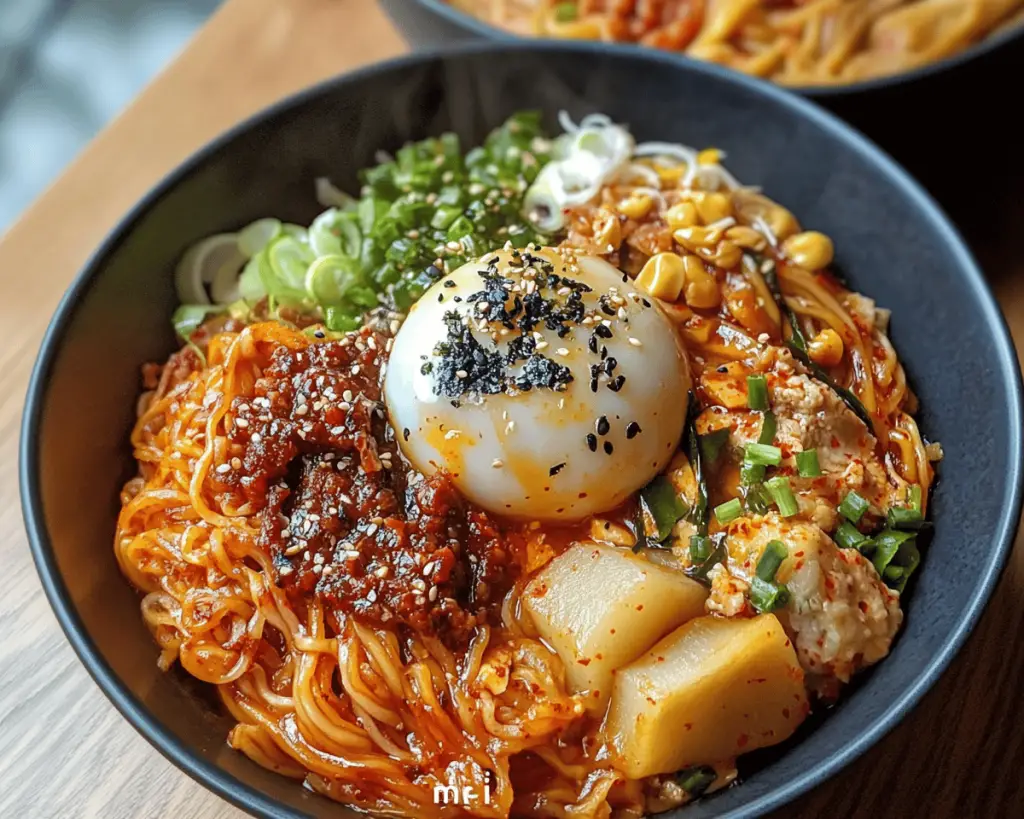There’s something so enchanting about the act of cooking, isn’t there? It’s like a warm hug for your soul, especially when you’re working with a recipe that speaks to your heart. One dish that truly embodies this notion for me is **Bibimmyeon**, a vibrant Korean cold noodle dish that manages to capture the spirit of summer and the comfort of home in every bite. I stumbled upon Bibimmyeon during a hot summer evening when I was desperately trying to avoid turning on the stove. My craving for something light yet satisfying led me to a small, dusty recipe book tucked away on my kitchen shelf—an heirloom passed down from my grandmother.
You know how you have those moments when you find an old photo that instantly transports you back in time? That’s how I felt when I flipped through those pages, filled with her familiar handwriting. The allure of Bibimmyeon called to me, promising a balance of flavors that spoke volumes about my Korean heritage. The combination of spicy, tangy, and sweet was like a dance party for my taste buds. It was almost like rekindling a lost connection, the flavors casting a spell of nostalgia.
As I tossed the cold noodles with the sauce and watched it splatter with vibrant colors onto my plate, I could almost hear my grandmother’s laughter echoing through the kitchen as she guided me through the recipe many years ago. Honestly, it felt like a happy accident when the dish turned out perfectly the first time. The silkiness of the noodles, the crunch of the vegetables, and that spicy-sweet sauce—it all came together, like a family reunion on a plate. And then, each time I make it, I reminisce about those sunny afternoons spent in her kitchen, learning the art of cooking it right.
When life gets a bit heavy or when summer heat makes me dream of cooler days, it’s Bibimmyeon that brings me back to balance. It’s quick to whip up, refreshing to eat, and feels like a moment of joy amid the chaos. So, let me take you on a little journey into the heart of this recipe—I promise it’s a trip worth taking.
What Goes Into Bibimmyeon?
Let’s dive into what makes Bibimmyeon so special. This isn’t just any dish; it’s a beautiful mix of textures and flavors that come together in a way that just makes sense. Here’s the breakdown:
– **Noodles**: The base of Bibimmyeon is made from **wheat noodles**, specifically thick, chewy ones known as **myeon**. They absorb the sauce wonderfully. You can also use **sweet potato starch noodles** if you’re feeling adventurous or if you want a gluten-free variation. I always like to boil just enough for one or two servings. Who wants leftovers that get mushy, right?
– **Cucumber**: I love using **English cucumbers** or **Korean cucumbers**. They’re crispy and refreshing, adding a nice crunch to the dish. Remember to deseed them to avoid watery noodles. I sometimes get a bit messy with my cutting, but hey, it’s all part of the fun!
– **Carrots**: Shredded or julienned **carrots** are essential for a hint of sweetness and a pop of color. Honestly, it’s one of those vegetables that I always keep on hand for just about any dish, one of my secret stocks, if you will.
– **Red Pepper Paste (Gochujang)**: This is where the magic begins! **Gochujang** gives the dish its signature heat and depth. It’s a Korean staple that I swear by. When I first discovered the flavor of spicy-sweet gochujang, it was like a lightbulb went off—how did I ever live without it?!
– **Soy Sauce**: I usually go for a low-sodium **soy sauce**—it makes for a great umami flavor without throwing off my sodium levels. Just a splash to round things out.
– **Sesame Oil**: A kiss of **sesame oil** elevates everything. I always cook with a high-quality brand; the kind that comes in a tiny glass bottle because a little goes a long way!
– **Sugar**: A pinch of **sugar** balances out the heat perfectly. Trust me when I say this; never skip it! It’s like finding that perfect balance in a friendship (you know, where you can laugh, cry, and have chocolate cake together).
– **Vinegar**: I sometimes use **rice vinegar** or even **apple cider vinegar**—it adds a nice zing to the sauce that really makes everything pop!
– **Sesame Seeds**: For the finishing touch, a sprinkle of **toasted sesame seeds** completes the presentation—and trust me, they’re worth it! It’s like confetti for your noodles.
– **Green Onions**: I always top off my Bibimmyeon with some freshly chopped **green onions**. They add another layer of freshness and color to the already vibrant dish.
– **Hard-Boiled Eggs (Optional)**: Now, here’s something you might not always find in traditional Bibimmyeon. I love adding a halved **hard-boiled egg** on top. It adds creaminess, and I’m convinced everything tastes better with an egg, right?
These ingredients come together to form a magical symphony of flavors. I never fail to be amazed at how something so simple can feel so complex and satisfying.
Is Bibimmyeon Actually Good for You?
About the health factor—let’s get real for a second. Bibimmyeon is super refreshing and has plenty of veggies, which is always a plus. But let’s not kid ourselves; it is a dish that leans toward the indulgent side with that generous drizzle of **sesame oil** and **gochujang**.
The good news? The ingredients are all pretty wholesome, and when made at home, you have control over what goes in. You can dial down on the sugar if you prefer, or even swap out some noodles for zoodles (zucchini noodles) if you want to go low-carb.
I like to think of Bibimmyeon as a delightful treat rather than a health food. A happy click of balance, indulgence, and nourishment. Honestly, when life gets tough, a spicy plate of Bibimmyeon feels like a hug in bowl form. Just don’t overdo the gochujang unless you’re ready for a fiery love affair with your taste buds!
Here’s What You’ll Need
– 200 grams of **wheat noodles** (or sweet potato starch noodles)
– 1 medium **cucumber**, julienned
– 1 medium **carrot**, julienned
– 2 tablespoons **gochujang** (adjust more or less, depending on your heat preferences)
– 1 tablespoon **soy sauce**
– 1 teaspoon **sugar**
– 1 tablespoon **sesame oil**
– 1 tablespoon **rice vinegar** (or apple cider vinegar)
– 1 tablespoon **toasted sesame seeds**
– 1-2 **green onions**, chopped
– 1 **hard-boiled egg**, halved (optional)
This will generously serve two people, or one really hungry soul.
How to Make Bibimmyeon Step-by-Step
Alright, let’s get cooking! While I’ve made some slight variations throughout the years, this is my tried-and-true method that never fails (well, almost never).
1. **Cook the Noodles**: Bring a large pot of salted water to a boil. Add the noodles and cook according to the package instructions. Once they’re done, drain and rinse with cold water until they’re nice and cool. I always do this to stop the cooking process. Nobody wants mushy noodles!
2. **Prep Your Veggies**: While the noodles are cooling down, grab your chopping board and julienne that cucumber and carrot. I like them about the same size for a more symmetrical look on the plate. Honestly, don’t stress it too much—just make them fun and colorful!
3. **Make the Sauce**: In a small mixing bowl, combine the **gochujang**, **soy sauce**, **sugar**, **sesame oil**, and **rice vinegar**. Give it a good mix until everything is combined. It should be a little thick; that means you’re on the right track! You can always taste it and adjust the heat level—more gochujang for spice or a touch more vinegar for tang!
4. **Combine Everything**: Now, this is where the fun really begins! In a large mixing bowl, toss the cooled noodles with the sauce and mix until everything is beautifully coated. I usually use my hands—seriously, it’s way more fun! Just don’t forget to wash your hands afterwards.
5. **Add the Veggies**: Toss in your julienned cucumber and carrot, and give it another gentle mix. Once everything is combined, drop those vibrant colors onto a plate—or bowl, whatever you fancy.
6. **Garnish Time**: Sprinkle with **toasted sesame seeds** and top with chopped **green onions**. If you’re feeling fancy, plop that hard-boiled egg on top too. Instant gourmet!
7. **Dig In**: Now, here’s the best part! Grab your chopsticks or a fork (because let’s be honest, I still sometimes use a fork), and experience the burst of flavors dance on your tongue. Seriously, it’s magic!
Little Extras I’ve Learned Along the Way
You know, cooking is all about making it your own. I’ve learned a few little tips and tricks over time that I’d love to share with you:
– **Spice Level**: If you’re hosting friends who might not have the same heat tolerance, make the sauce a bit milder and let them add more gochujang to their liking.
– **Veggie Variations**: Feel free to switch up the vegetables! Bell peppers, radish, or even avocados (oh, I love avocados!) can work well in this dish.
– **Noodle Shortcuts**: If time is not on your side, you can use those pre-cooked noodles you find in the grocery store. They make your life easier, and I’m all for that!
– **Vegan Twist**: To cater to vegan folks, simply omit the egg and replace the sugar with agave or maple syrup. It’s just as delicious!
– **Batch it Up**: Sometimes, I make a big batch and keep the sauce separate. That way, I can grab some noodles and veggies for a quick meal whenever needed. Just don’t mix it until you’re ready to eat; soggy noodles are a no-go.
What I love most about Bibimmyeon is its adaptability; it grows with you and your taste buds. No matter how you tweak it, it always finds a way to feel comforting and delicious.
This one means a lot to me. It’s tied to family memories and summer evenings, and I hope that it resonates with you too. Give it a try and let me know how yours turns out. I’m always eager to hear about your twists and what memories it inspires for you in the kitchen! Happy cooking!



